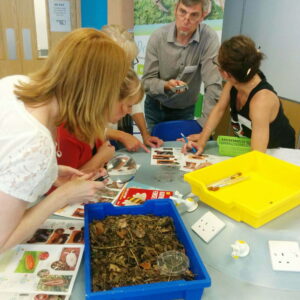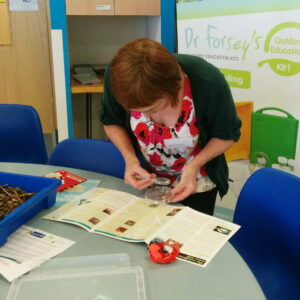Identify – Woodlice
This activity was created as part of a Gratnells What’s In My Tray CPD workshop for secondary science teachers and technicians to support practical work and delivery of the curriculum. It can be carried out as a stand-alone activity for students or combined with other activities from the session to form a STEM carousel.


You will need (per team of 4):
- 2 x Shallow Gratnells (F1) trays with lids
- A variety of woodlouse species from your local outdoor area (it should be possible to find 3-4 different species)
- 5 x Petri dish or similar sized, shallow, vented transparent pots with lids
- 4 x 1-2cm wide paint brushes
- 4 x Hand held magnifying glass
- 3 x Wet paper towels
- 5 x Large handfuls of damp leaf litter and woodland detritus
- 2 x Field Studies Council Woodlouse Name Trail
- 1 x Paper and pencil
This activity also works for individuals or smaller teams, just increase the amount of time allocated to complete it.
This activity can be repeated multiple times using the same equipment, just be mindful of how long the woodlice are out of their natural habitat and ensure they are kept in cool, damp and dark conditions as much as possible.
Tips: Collect woodlice carefully and as close to the time of the activity as possible. Look under logs and rocks and in leaf litter in dark and damp locations, or under plant pots, loose paving slabs or bark. Seek out a variety of woodlouse species. Use either your hands or the paint brushes to place them gently into the petri dishes or shallow pots. Collect several examples of each species. Keep them in damp, dark and cool conditions and return them to their natural habitat as soon as possible after the activity.
Preparation:
Place the wet paper towels into the bottom of one shallow Gratnells (F1) tray. Add a shallow layer of damp leaf litter and woodland detritus. Place a mixture of woodlice into each petri dish with a small amount of detritus and put the lid on. Place the petri dishes on top of the damp leaf litter. Put the lid on the Gratnells tray. Place all other equipment in to the second Gratnells tray and put the lid on. Store the trays in a cool and dark place until needed.
What to do:
- Approach the trays and lift the lid
- Use the Woodlouse Name Trail to identify the different species of woodlice. You may carefully lift up the petri dishes and use the magnifying glass to get a closer look but do not remove the woodlice from the dishes.
- Write their Latin names down in alphabetical order.
- 1 point per correctly identified species.
Tidy up time:
- When the time allocated for the activity has ended, carefully put all the petri dishes back on to the leaf litter and put the lid back on the tray. Place all the other equipment back into the second tray and replace the lid.
Answers:
The type and number of woodlice you will find in your local outdoor area will differ depending on where you are, where you look and the time of year. You can usually expect to find three or four different species. Use the name trail as you are collecting the woodlice and record the species ahead of starting the activity, so you have the answers ready for when you need them at the end.
Other things to try:
- Go outdoors and conduct a study of woodlouse species found across your local area. Where did you find most woodlice? Do different species prefer different habitats? Is the underlying soil type important? Do the species differ over the year? Can you measure abiotic conditions such as air and soil temperature, light intensity and humidity (a data logger will be useful here), aspect and slope? This will give you a record of many of the variables that could impact on your findings.
- Using your findings, can you create additional or improved habitats for woodlice in your school grounds? Once the new habitats have had time to establish, repeat your study and assess the impact on the abundance and diversity of woodlice species found.
Health & Safety
As with all Gratnells Learning Rooms What’s In My Tray activities, you should carry out your own risk assessment prior to undertaking any of the activities or demonstrations. In particular, wash hands thoroughly and cover cuts or areas of broken skin to reduce the risk of exposure to soil and water borne pathogens.

